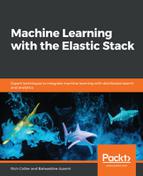ML obviously needs data to analyze (and use to build and mature the statistical models). This data comes from your time series indices in Elasticsearch. The datafeed is the mechanism by which this data is retrieved (searched) on a routine basis and presented to the ML algorithms. Its configuration is mostly obscured from the user, except in the case of the creation of an advanced job in the UI (or by using the ML API). However, it is important to understand what the datafeed is doing behind the scenes.
Similar to the concept of a watch input in alerting, the datafeed will routinely query for data against the index, which contains the data to be analyzed. How often the data (and how much data at a time) the datafeed queries depends on a few factors:
- bucket_span: We have already established that bucket_span controls the width of the ongoing analysis window. Therefore, the job of the datafeed is to make sure that the buckets are full of chronologically ordered data. You can therefore see that the datafeed will make a date range query to Elasticsearch.
- frequency: A parameter that controls how often the raw data is physically queried. If this is between 2 and 20 minutes, frequency will equal bucket_span (as in, query every 5 minutes for the last 5 minutes' worth of data). If the bucket_span is longer, the frequency, by default, will be a smaller number (more frequent) so that the overall long interval is not expected to be queried all at once. This is helpful if the dataset is rather voluminous. In other words, the interval of a long bucket_span will be chopped up into smaller intervals simply for the purposes of querying.
- query_delay: This controls the amount of time "behind now" that the datafeed should query for a bucket span's worth of data. The default is 60s. Therefore, with a bucket_span value of 5m and a query_delay value of 60s at 12:01 PM, the datafeed will request data in the range of 11:55 AM to midnight. This extra little delay allows for delays in the ingest pipeline to ensure no data is excluded from the analysis if its ingestion is delayed for any reason.
- scroll_size: In most cases, the type of search that the datafeed executes to Elasticsearch uses the scroll API. Scroll size defines how much the datafeed queries to Elasticsearch at a time. For example, if the datafeed is set to query for log data every 5 minutes, but in a typical 5-minute window there are 1 million events, the idea of scrolling that data means that not all 1 million events will be expected to be fetched with one giant query. Rather, it will do it with many queries in increments of scroll_size. By default, this scroll size is set conservatively to 1,000. So, to get 1 million records returned to ML, the datafeed will ask Elasticsearch for 1,000 rows, a thousand times. Increasing scroll_size to 10,000 will make the number of scrolls be reduced to a hundred. In general, beefier clusters should be able to handle a larger scroll_size and thus be more efficient in the overall process.
There is an exception, however, in the case of a single metric job. The single metric job (described more later) is a simple ML job that allows only one time series metric to be analyzed. In this case, the scroll API is not used to obtain the raw data—rather, the datafeed will automatically create a query aggregation (using the date_histogram aggregation). This aggregation technique can also be used for an advanced job, but it currently requires direct editing of the job's JSON configuration and should be reserved for expert users.
